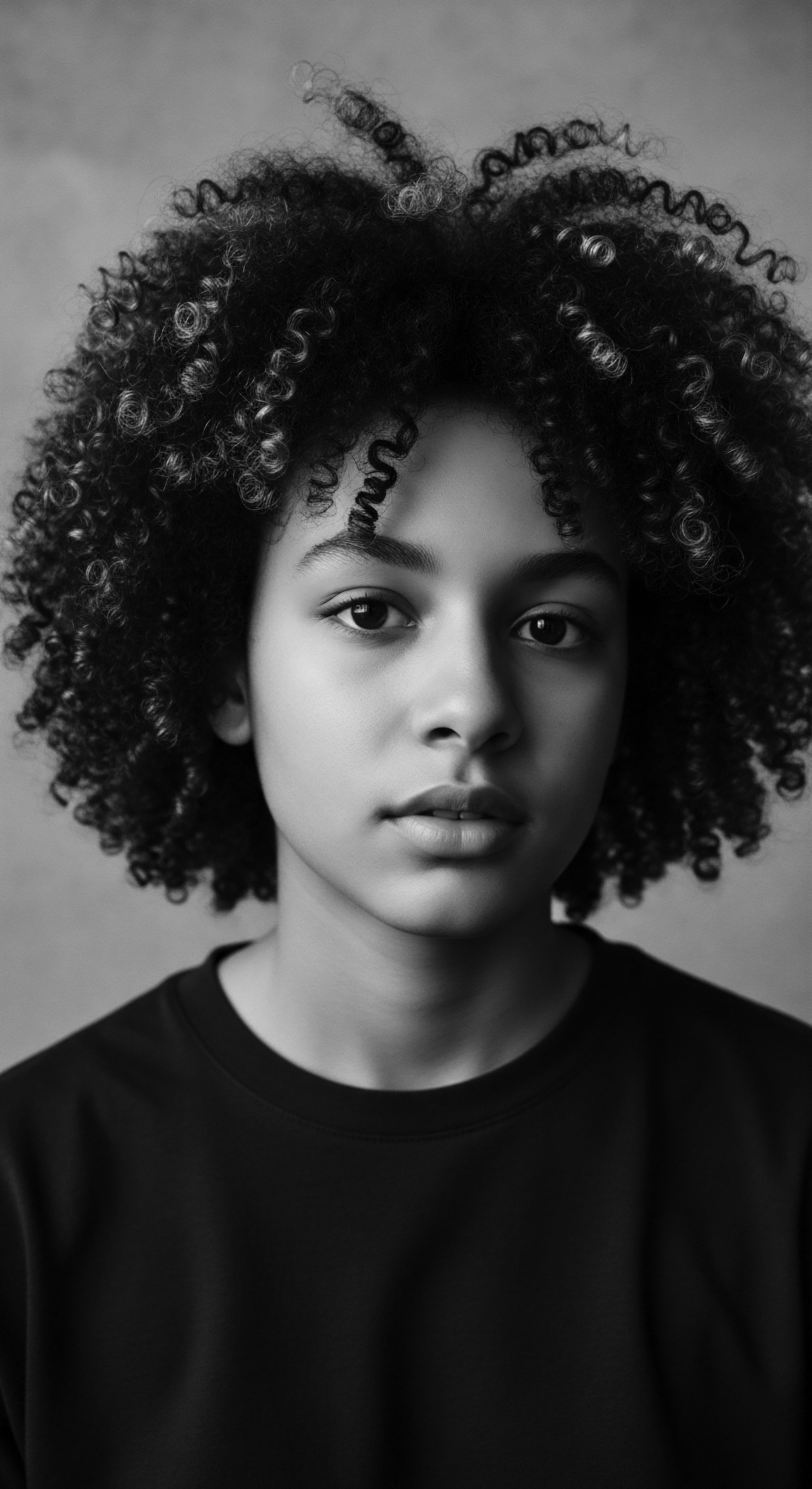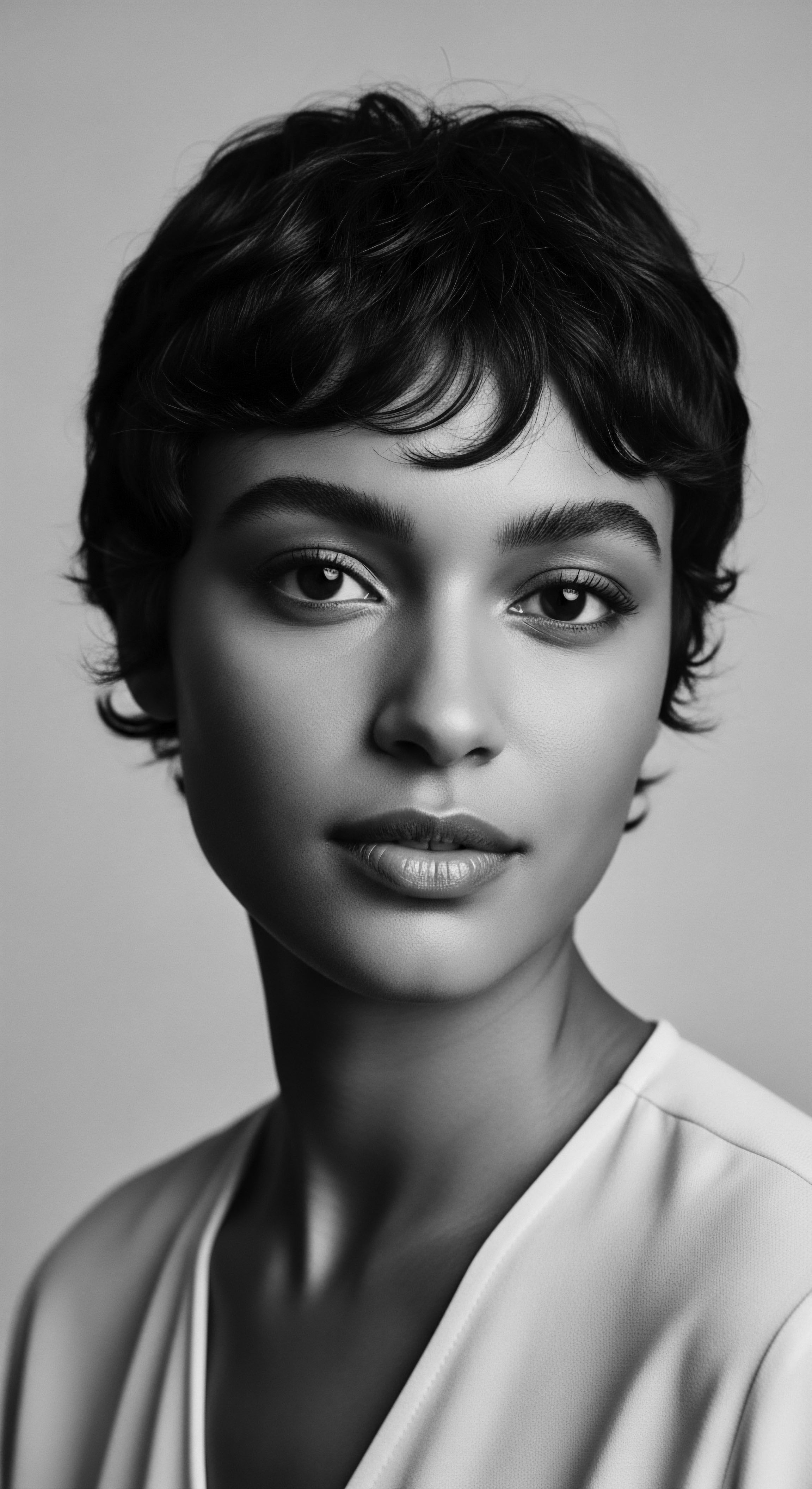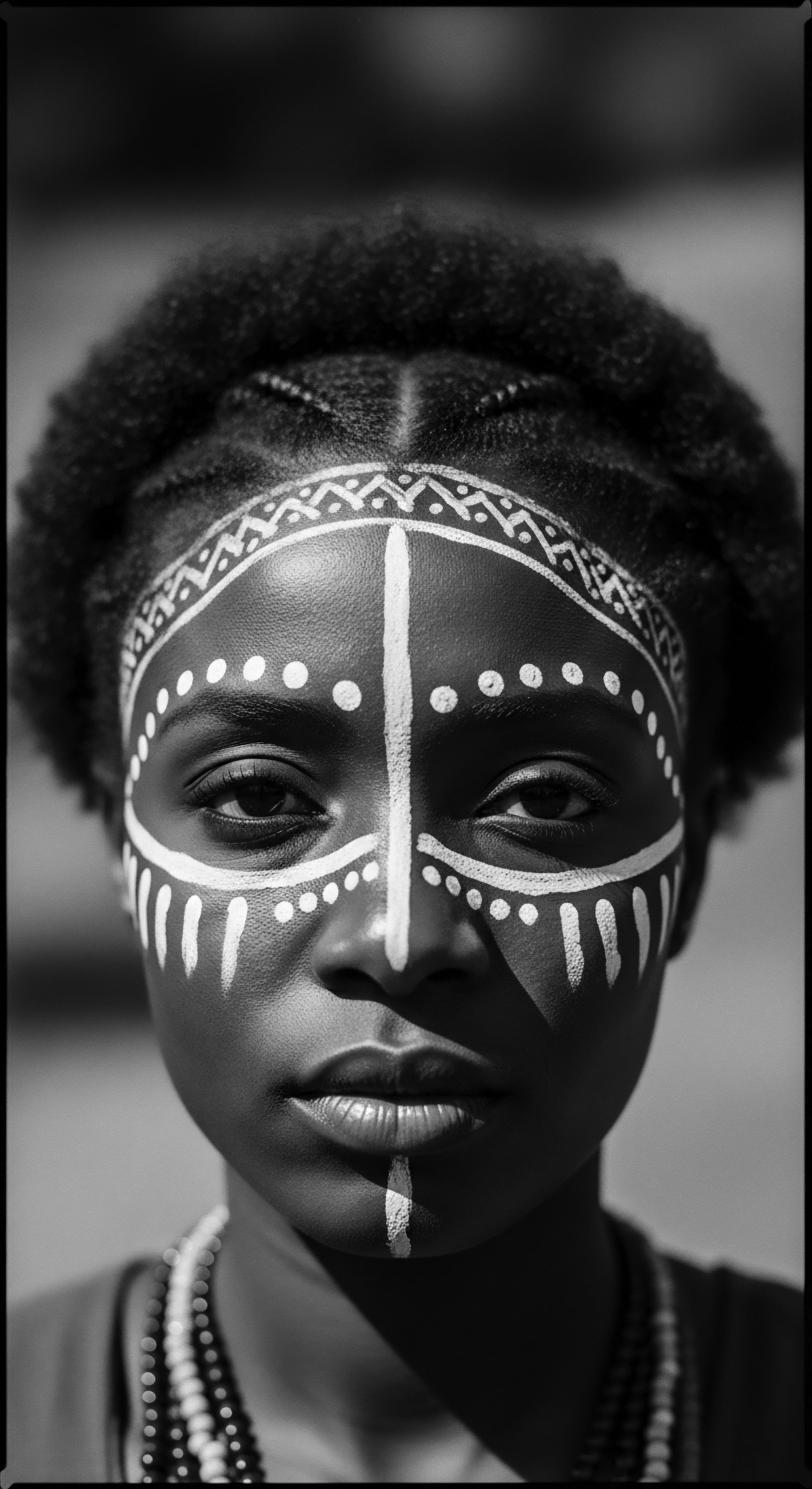
Roots
Consider the deep heritage woven into the very concept of a bonnet for textured hair. This is not simply a fabric covering. It is a vessel of ancestral wisdom, a quiet guardian of coiled strands, carrying the echoes of sun-drenched lands and arduous journeys.
For those with hair that dances in spirals and springs, the choice of material for a head covering has always held significance beyond mere adornment. It speaks to protection, preservation, and a profound connection to the earth’s offerings and human ingenuity.
To truly understand the textiles that historically inspired bonnet materials, we must journey back to the very foundations of how textured hair was understood and tended in ancient civilizations and across the African diaspora. Early practices were rooted in intimate knowledge of the hair’s unique structure and its interaction with the environment. Whether guarding against the harsh desert sun or the biting humidity of tropical climates, head coverings served a dual purpose ❉ practical protection and symbolic expression of identity, status, or spiritual beliefs. This dual function has remained a constant thread through centuries, from the ancient Nile Valley to the contemporary bedrooms where silk-lined bonnets now rest.

Ancient Fibers and Hair Physiology
The very biology of textured hair, with its inherent coil and tendency towards dryness, demanded specific considerations. Unlike straighter hair types, the helical structure of highly coily or curly hair means natural oils from the scalp travel down the strand with greater difficulty. This characteristic makes such hair more susceptible to moisture loss and breakage from friction.
Ancient communities, through observation and inherited wisdom, intuited these vulnerabilities, even without modern scientific terminology. Their choice of textiles for head coverings reflected this understanding.
The wisdom of ancestral care intuitively grasped the unique needs of textured hair, long before scientific explanation became common.
Consider the materials readily available in various historical contexts. In ancient Egypt, for instance, both men and women wore headpieces, including wigs and coverings, to protect their hair from the harsh desert elements. These often used Linen, a natural fiber derived from the flax plant. Linen, while breathable, can sometimes be rough on hair cuticles, particularly if not finely woven.
However, it offered crucial protection from sun and dust, and was often paired with nourishing oils for hair care. Egyptians also used human hair, sheep’s wool, or other vegetable fibers for wigs, which were often styled with beeswax and animal fat. The deliberate care and styling of natural hair and wigs points to a deep, heritage-based appreciation for hair’s role in personal and social presentation.
The choice of textiles was also tied to the economic and social structures of the time. While simpler, readily available fibers like unrefined cotton or specific plant fibers might have been used for everyday, functional wraps, more refined or imported materials were reserved for those of higher status. This distinction, however, did not diminish the fundamental protective role of the head covering.

How Did Early Textile Choices Serve Hair Protection?
Across various African societies, the textile choices for head coverings were diverse, reflecting regional resources and cultural practices. Cotton, often hand-spun and locally dyed, was a pervasive material. Its absorbency, while sometimes a drawback for moisture retention in modern contexts, offered a practical solution for wicking away sweat and keeping the scalp cool in warm climates.
These early head wraps, known by names such as Gele in Nigeria or Duku in Southern Africa, served not only to protect but also to communicate social standing, marital status, or spiritual beliefs. The intricacy of the wrap, the color, and the pattern all spoke a language understood within the community.
- Linen ❉ Utilized in ancient Egypt for protection against sun and dust, often with hair treated with oils.
- Cotton ❉ A common fiber in various African communities, used for everyday headwraps for practical purposes like sweat absorption and sun protection.
- Plant Fibers ❉ Employed in different forms for ancient wigs and hair extensions, sometimes alongside human hair.
The understanding of hair anatomy, albeit an ancestral one, guided these choices. The coils and curls, though beautiful, were recognized as needing a shield from the elements and from environmental stressors. These early textiles, therefore, were the first bonnets, born from necessity and shaped by cultural expression, embodying a collective wisdom regarding hair preservation.

Ritual
The journey of textured hair care from antiquity to today is steeped in ritual, where practices are passed down through generations, each movement carrying the weight of history and care. Head coverings, long before the modern bonnet, became integral to these traditions. They were not merely pieces of cloth; they were extensions of identity, tools for maintenance, and quiet declarations of selfhood, even in the face of immense struggle. The material chosen for these wraps and coverings held functional and symbolic weight, influencing both the health of the hair and its cultural presentation.
The historical textiles that influenced bonnet materials for textured hair are intrinsically linked to the styling practices and transformations common across the African diaspora. Consider the West African gele, an elaborate headwrap tied with precision, often for celebrations and special occasions, signifying status and cultural affiliation. These were not always simple fabrics; some geles were made from stiffer materials like Aso-Oke or Damask, allowing for complex, architectural forms that held their shape. While not always worn for sleep, the principles of protection and adornment found in these wraps undoubtedly influenced the conceptual framework for hair coverings.

Textiles of Protection in Enslavement
During the horrific period of transatlantic chattel slavery, head coverings for Black women in the Americas took on layered meanings. Initially, these were often enforced by slaveholders as a marker of servitude, using basic, unornamented fabrics like dull Cotton Rags or Handkerchiefs. Yet, in a profound act of resistance and resilience, enslaved Black women reclaimed these simple cloths, transforming them into symbols of identity and dignity.
They adapted whatever materials were available, like scraps of fabric or old T-shirts, to protect their hair from the harsh conditions of labor, including sun, sweat, and grime. This practical use was intertwined with a deeper intention ❉ preserving their hair, a sacred connection to their heritage and self.
Within the painful history of enslavement, the headwrap transformed from a symbol of subjugation into an act of enduring self-preservation and defiant cultural expression.
The ability of certain textiles to reduce friction and retain moisture became a matter of necessity for survival. Coarse fabrics, such as low-thread-count cotton, can absorb moisture from hair, leading to dryness and breakage. While precise scientific understanding of hair cuticles was absent, the lived experience of breakage and moisture loss certainly informed practical adjustments.
Enslaved women, with ingenuity, would sometimes wrap their hair with string or even other hair strands to help maintain and protect it under their head coverings. This speaks to an intuitive, generational understanding of what worked best for hair preservation, a wisdom that would later inform the preference for smoother materials.
A significant historical example of textile influence and cultural adaptation can be observed in the Tignon Laws of 1785 in Spanish colonial Louisiana. These laws mandated that Afro-Creole women wear turban-like headwraps to distinguish them from white women, undermining their perceived allure. In response, these women adorned their tignons with jewels, ribbons, and feathers, utilizing luxurious fabrics to assert their dignity and express a defiant fashion statement, thereby transforming an oppressive measure into a symbol of pride and resilience. The madras cloth, imported from India, became a notable fabric for these elaborate headwraps in the Caribbean and parts of the Americas.
Its vibrant patterns provided a medium for this visual resistance. This act demonstrates how textiles, even those imposed, were subverted to maintain cultural identity and hair health within a challenging historical context.

What Did These Textiles Offer to Hair Care?
The textiles chosen for head coverings, whether imposed or self-selected, offered different qualities vital for textured hair:
- Protection from Elements ❉ Fabrics shielded hair from sun, wind, and dust, which could otherwise lead to dryness and damage.
- Containment and Style Preservation ❉ Wraps held hairstyles in place, extending their longevity, particularly for intricate braids or twists.
- Reduction of Tangling ❉ A contained hairstyle under a wrap was less prone to tangling, especially during labor or sleep.
- Moisture Management ❉ While basic cotton could absorb moisture, the act of covering itself could help retain some natural oils and applied hair treatments, preventing rapid evaporation.
Even the simplest head-tie, sometimes crafted from repurposed clothing, served as a barrier between delicate strands and the harsh realities of daily existence. This pragmatic approach to hair preservation, born of necessity and passed down through communal knowledge, laid the groundwork for the modern bonnet. The material was secondary to the act of covering, but the practical lessons learned from various fabrics contributed to the eventual preference for smoother surfaces for nighttime protection.

Relay
The story of bonnet materials for textured hair is a relay race through time, with ancestral practices handing off wisdom to modern science, always with the precious cargo of hair heritage in tow. The shift towards specific, smoother materials like silk and satin for bonnets for textured hair represents a culmination of centuries of intuitive understanding, now validated by contemporary scientific inquiry. These materials were not universally available to all ancestors, particularly those experiencing enslavement, who often relied on more common, coarser fabrics. Yet, the deep-seated yearning for hair protection, a legacy of ancestral care, propelled their eventual prominence.
The emphasis on nighttime care and protective coverings holds deep roots in cultural memory. African American women, even after slavery, continued the practice of wrapping their hair at night. This was a crucial method for preserving hairstyles, whether natural textures or heat-pressed styles, for extended periods.
This practice minimized the need for frequent restyling, which, in turn, reduced potential damage to the hair. The materials used were often what was accessible, yet the idea of a smooth, protective layer was always conceptually present.

What Properties Make Silk and Satin Ideal for Textured Hair Bonnets?
The ascendance of Silk and Satin as the preferred materials for modern bonnets represents a sophisticated evolution of this ancestral wisdom. Silk, a natural protein fiber, has a remarkably smooth surface. This smoothness reduces friction between the hair and the fabric, which is particularly vital for textured hair, prone to tangling and breakage.
When hair rubs against rougher materials like cotton, the cuticle layer can be lifted and damaged, leading to frizz, split ends, and dryness. Silk’s structure, composed of proteins like fibroin and sericin, contributes to its soft, lightweight, and smooth properties.
| Textile Cotton |
| Historical Context/Traditional Use Widely accessible, used for everyday headwraps and enforced coverings during enslavement. Practical for sweat absorption in warm climates. |
| Modern Hair Health Properties (Relevance to Textured Hair) Absorbent; can draw moisture from hair, potentially leading to dryness and friction, though breathable. |
| Textile Linen |
| Historical Context/Traditional Use Used in ancient Egypt for protective head coverings against environmental elements like sun and dust. |
| Modern Hair Health Properties (Relevance to Textured Hair) Breathable, but can be somewhat coarse, potentially causing friction on hair if not of a very fine weave. |
| Textile Silk |
| Historical Context/Traditional Use Historically a luxury item, used by elites in parts of Africa and Asia for ceremonial headwear and hair protection. |
| Modern Hair Health Properties (Relevance to Textured Hair) Exceptionally smooth, reduces friction, retains hair moisture, hypoallergenic, and breathable. Ideal for preventing breakage, frizz, and maintaining hydration for textured hair. |
| Textile Satin (Synthetic) |
| Historical Context/Traditional Use A modern, more accessible alternative, designed to replicate silk's beneficial properties. Popular from the 20th century onwards for hair protection. |
| Modern Hair Health Properties (Relevance to Textured Hair) Smooth surface reduces friction and helps retain moisture, offering similar benefits to silk for hair protection at a lower cost. |
| Textile The evolution of bonnet materials showcases a continuous effort to provide optimal protection and care for textured hair, building upon ancestral insights and adapting to new resources. |
Beyond friction reduction, silk also aids in Moisture Retention. Textured hair, particularly its coily and curly forms, can be prone to dryness because its unique structure makes it challenging for natural oils to travel evenly down the hair shaft. Unlike cotton, which is highly absorbent and can wick away precious moisture from hair and scalp, silk absorbs very little moisture.
This means that the hair’s natural oils, along with any applied hydrating products, are more likely to remain in the hair, contributing to hydration and preventing dryness throughout the night. This attribute is crucial for maintaining the definition of curls and reducing frizz, which is a common concern for many with textured hair.

Are There Other Hair Benefits from These Modern Choices?
The material choice extends to other benefits for hair and scalp wellness. Silk is naturally Hypoallergenic, resisting dust mites and mold, which makes it a preferred choice for individuals with sensitive scalps or allergies. Its breathability also prevents excess moisture buildup from sweat or oiliness, mitigating issues like dandruff and scalp irritation. These scientific validations now explain the intuitive benefits that generations of textured hair wearers sought through various protective coverings.
The historical significance of these materials extends beyond their physical properties. The act of wearing a bonnet, particularly one made from a material known for its protective qualities, stands as a quiet yet powerful affirmation of self-care and a connection to a legacy of resilience. It is a daily ritual that echoes the protective headwraps of ancestors, adapting to modern materials while upholding the timeless value of safeguarding textured hair as a symbol of identity and heritage. This daily practice becomes a modern continuation of age-old traditions.

Reflection
The journey from rudimentary head coverings to the meticulously crafted bonnets of today represents more than just an evolution in textile technology. It is a profound testament to the enduring spirit of textured hair heritage. Each thread, from the coarse cotton of historical necessity to the smooth silk of contemporary luxury, carries a story of protection, resistance, identity, and profound self-care. The materials that once shielded heads from the sun or marked social standing now whisper a bedtime story of hydration and reduced friction, a modern chapter in an ancient saga.
Roothea’s ‘Soul of a Strand’ ethos reminds us that textured hair is a living archive, each coil holding ancestral memory. The simple bonnet, in its historical lineage, perfectly embodies this. It is a symbol that transcends time, connecting generations of Black and mixed-race individuals to their forebears who understood, perhaps without scientific nomenclature, the delicate balance required to care for their unique crowns.
The resilience demonstrated by those who transformed symbols of oppression into declarations of dignity, as seen in the Tignon Laws response, continues to inform our understanding and appreciation for these everyday objects. This heritage is not static; it is a dynamic, living legacy that breathes through every mindful act of hair care.
To wear a bonnet today, recognizing its lineage, is to participate in a sacred ritual. It is to acknowledge the ingenuity of ancestors who adapted available materials for hair preservation, and to honor the resilience that ensured cultural practices survived against overwhelming odds. This simple accessory, now a staple in many textured hair regimens, stands as a beacon of cultural continuity, a quiet celebration of identity, and a promise of care for the strands that carry centuries of stories within them. The choice of a silk-lined bonnet, therefore, is not merely a preference for comfort or a pursuit of beauty; it is an act of deep reverence, a continuation of a heritage-rich dialogue between hair, history, and healing.

References
- Griebel, Helen Bradley. “The African American Woman’s Headwrap ❉ Unwinding the Symbols.” Art, Design, and Visual Thinking .
- Katsande, Rukariro. “The history & meaning of head wraps across Africa.” Wilderness, 2015.
- Leone Culture. “Exploring the Significance Of Headwraps In African Fashion And Traditions.” Leone Culture, 2023.
- JD Institute of Fashion Technology. “HEADWRAPS ❉ HISTORY AND EVOLUTION.” JD Institute of Fashion Technology, 2021.
- LuxCare. “The Evolution of Headscarves ❉ from ancient Egypt to the red carpet.” LuxCare .
- Paradisefold. “Silk v. Satin ❉ The Showdown!” Paradisefold, 2023.
- Tihara Smith. “Caribbean Madras Fabric ❉ Threads That Connect Continents.” Tihara Smith, 2025.
- Hype Hair. “Unveiling the History of the Hair Bonnet for Black Women.” Hype Hair, 2023.
- Noireônaturel. “How frizzy hair saved the lives of slaves.” Noireônaturel, 2024.
- Sino Silk. “What Is A Bonnet The Ultimate Guide.” Sino Silk, 2025.
- Dtex Homes. “Which Pillowcase Is Better for Your Hair?” Dtex Homes, 2025.
